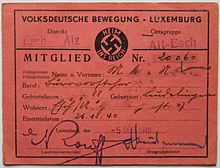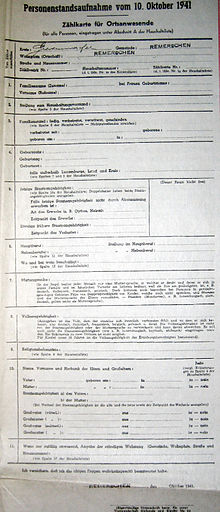Volksdeutsche movement
The popular German movement (Vd) was an association of Luxembourg from membership in the "Germanic race" ( ethnic German ) was convinced and during the occupation of Luxembourg in World War II with the slogan " Heim ins Reich " connection to the Nazi state to tried to achieve.
founding
The predecessor of the VdB, the “ Luxembourg Society for German Literature and Art ” (GEDELIT), was headed from 1935 by Damian Kratzenberg . Kratzenberg, a Luxembourg National Socialist , campaigned for the integration of the Grand Duchy into the German Empire and cited the “ Germanness ” of the Luxembourgers as a historical and linguistic justification. Among other things, the "GEDELIT" also made propaganda in schools and gathered groups of schoolchildren built up under National Socialism in a GEDELIT restaurant. After the Wehrmacht occupied the neutral Grand Duchy on May 10, 1940 on Hitler's orders , the “Volksdeutsche Movement (VdB)” was founded 7 days later in Luxembourg (city) . In his function as chairman of the VdB, Kratzenberg was now subordinate to the head of civil administration (CdZ), Gauleiter Gustav Simon .
membership
In order to convert the opposed Luxembourgers, a lot of effort was tried to get them to join the VdB. A propaganda campaign for the Luxembourg People's Boys (LVJ) was also used in schools . Both campaigns failed. On July 6, 1940, the VdB made the following appeal:
“Luxembourger, hear the voice of blood! She tells you that you are German by race and language. Luxembourgishism in all honor! Because true Luxembourgish is pure German. "
Because of the failure, the CdZ had the officials and teachers submit a declaration by which they undertook to "conscientiously carry out" all orders of the German civil administration. Anyone who refused should be dismissed immediately and had to face a professional ban. At the same time officials had to attend training courses in the German Reich in order to gain knowledge of German legislation and administrative practice. The officials deliberately rejected the Reich German regulations and institutions and made no secret of their hostile attitude.
On the morning of September 1st, some post officials finally decided to collect the VdB membership cards and send them back. In front of the assembled staff, a young postal sub-inspector read out the text in which Hitler had once assured that he would respect Luxembourg's neutrality in any case. After the employees resisted their Reich German superiors, who ordered them to return to their workplaces, they called the Gestapo . After a few interrogations, the post office sub-inspector and another post office official were arrested and taken to the Hinzert concentration camp , where both were shot.
The CdZ Simon and the country manager of the VdB tried to persuade the Luxembourgers to become members through a ruse. On October 24, 1940, they announced that the VdB would no longer accept any new members. Exceptions could only be permitted by the regional leader on the “personal request of the local group leader of the Volksdeutsche movement”. And threateningly it went on: “The Volksdeutsche movement is the bearer of the German idea. Those who do not stand by her stand outside the community, because the Luxembourg community is German. "
He announced that anyone who was not a member of the VdB had to expect to be dismissed and to be classified as "you do not offer any guarantee". This category of Luxembourgers was compulsory in the German Reich. Sentenced to forced labor, many Luxembourgers had to work on the Eifel motorway or were forced to do other physically strenuous work.
At the beginning of October 1940, the VdB had around 5,000 members, including many staunch National Socialists. At the end of October the number of members rose to 40,000 and in December 1940 to 50,000. By mid-1941, around 70,000 Luxembourgers were enrolled in the VdB. The civil administrator announced that any civil servant who defied his duties or otherwise conspicuously should be dismissed on the spot.
From 1941
In a last attempt, the civil administrator had a civil status camouflaged as a census drawn up on October 10, 1941 , in which the Luxembourgers were to acknowledge their German nationality and thus, as it were, to approve a "voluntary" affiliation to the Reich.
The people should be asked three questions about " nationality ", " mother tongue " and " ethnicity ", whereby in the suggestive formulated explanations Luxembourgish was described as an invalid dialect , which should result in the only logical answer being "German". But the ruse failed. The Luxembourg Resistance found out about the plan and spread the word that all Luxembourgers should answer with dräimol Lëtzebuergesch ("three times Luxembourgish"). A test run by the civil administration then failed fatally, which is why the survey was canceled.
So the occupiers realized that they could not overcome the resistance in the population. The occupiers' policy towards the Luxembourgers changed and became much more brutal. The Volksdeutsche movement lost its importance and hardly played a role until the end of the war.
On July 20, 1944, a Luxembourger shot the local group leader of the Volksdeutsche movement in Junglinster . In retaliation, Heinrich Himmler ordered the execution of ten uninvolved Luxembourgers in German custody. Three of them were shot at the Uhlrather Hof , the remaining seven in Lingen .
The head of the VdB, Damian Kratzenberg, was able to flee to Weißenberg a few days before the liberation by the Allies on September 1st . A letter to his daughter after the end of the war betrayed him, however, and Kratzenberg was taken to Luxembourg, where he was tried. The process took four days. On August 1, Damian Kratzenberg was sentenced to death and on 11 October 1946, the shooting of the barracks on the Holy Ghost Plateau in Luxembourg (city) shot .
See also
literature
- Wacław Długoborski (ed.): Second World War and social change. Axis powers and occupied countries (= critical studies on historical science . Volume 47). Vandenhoeck & Ruprecht, Göttingen 1981, ISBN 3525357052 ; Volksdeutsche movement passim; can be viewed online
- Damian Kratzenberg: The ethnic German movement in Luxembourg (= Home to the Reich! Volume 1). Moselfränkischer Zeitungsverlag, Luxemburg undated (1941).
- Paul Dostert: Luxembourg between self-assertion and national self- surrender . German occupation policy and the Volksdeutsche movement 1940 - 1945. Impr. Saint-Paul, Luxemburg 1985. Zugl. Diss. Phil. University of Freiburg im Breisgau 1984
- Josef Strzygowski : Europe's power art in the context of the earth. A fundamental argument about the nature and development of the ten thousand year madness. Violence by God's grace instead of national order, church instead of faith, education instead of talent; from the northern standpoint set in the ethnic German movement as planned. Reprint: Verlag der Manufactur, Horn-Bad Meinberg 1999 ISBN 9783880809772
- Hans-Erich Volkmann: Luxembourg under the sign of the swastika: a political economic history 1933 to 1944 . Schöningh, Paderborn 2010, ISBN 978-3-506-77067-7 , pp. 221-241.
Individual evidence
- ^ Hostage murder of three young Luxembourgers. Retrieved August 1, 2018 .
- ↑ Note the author. Reprint of the 3rd edition expanded to include the subject index. Wiener Verlag, Vienna 1943.

